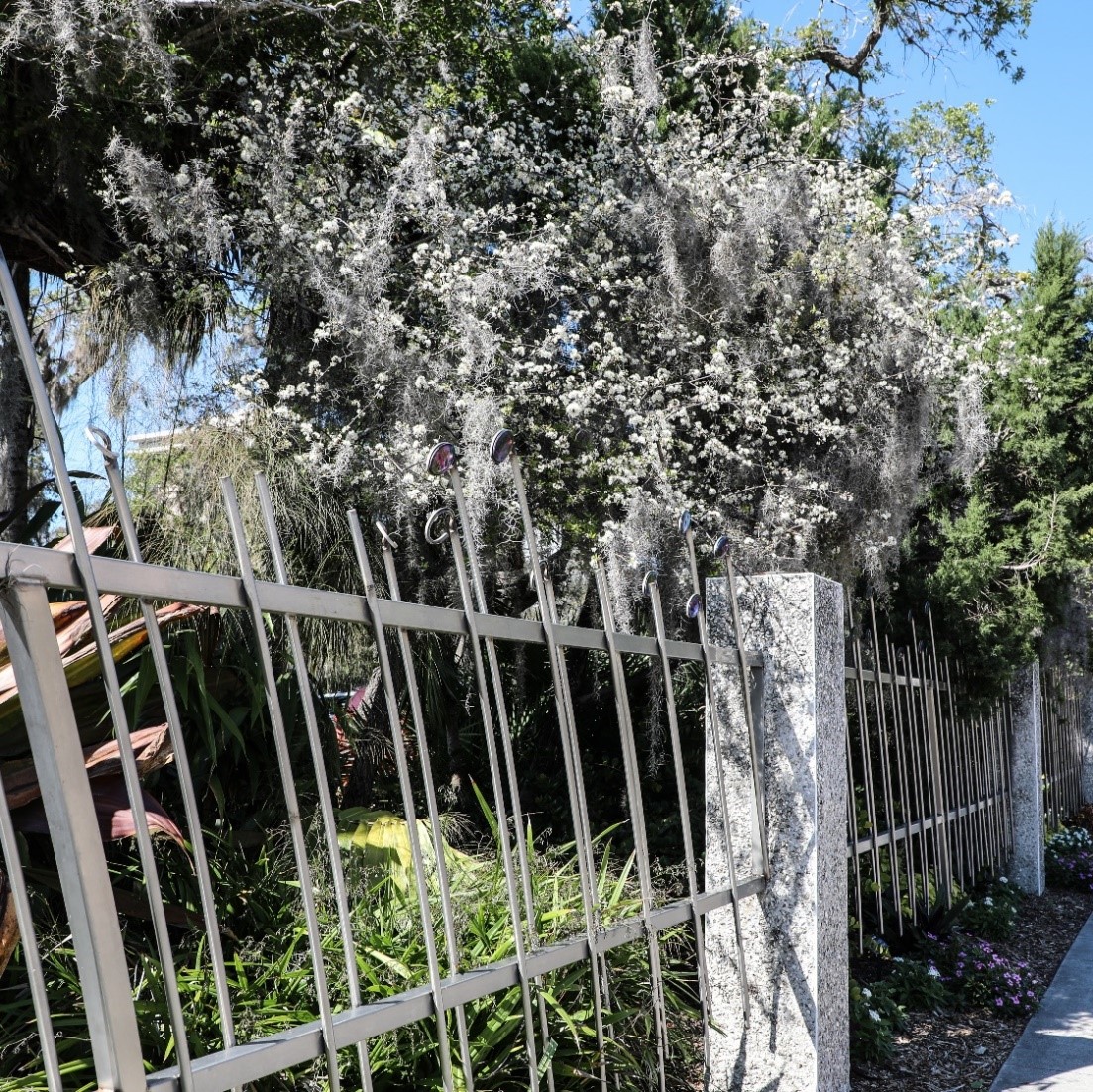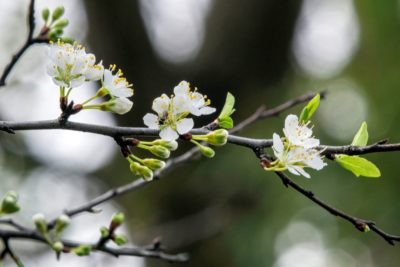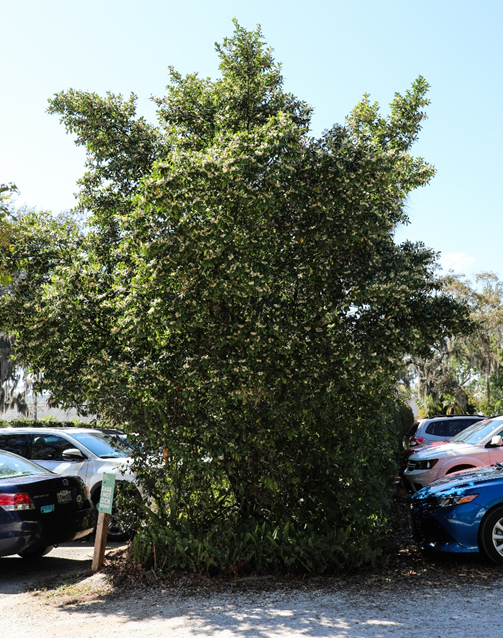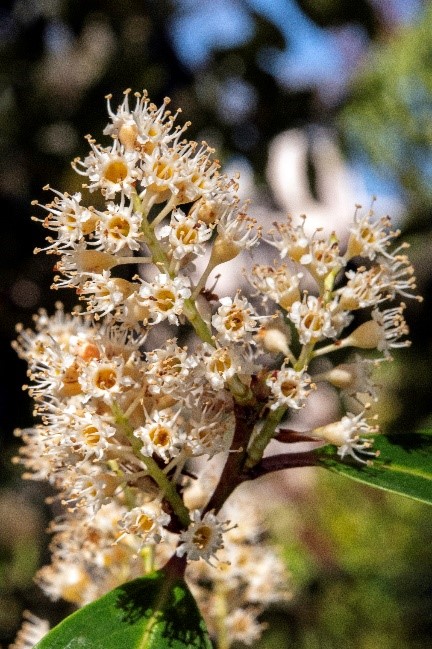Written by Shawn McCourt, Ph.D., Plant Records Keeper

Figure 1. Blooming flatwoods plum (P. umbellata) draped in Spanish moss on the perimeter of MSBG’s downtown campus (Photo by Sandra Robinson)

Figure 2. Chickasaw plum (P. angustifolia) in bloom along Mound Ave. at the downtown campus (Photo by Aaron Fink).
New transplants to Florida from more northerly latitudes often lament the seeming lack of seasonal change in Florida’s “endless summer.” They also bemoan the loss of the spring flowers and trees they had in their gardens and parks “back home.” To them, subtropical Florida is missing dramatic indicators of the change of seasons such as showy spring flowers, warm, green summer days redolent with the smell of freshly mown grass, fiery autumn leaves, and bare trees dusted with winter snow. The turn of the seasons is more subtle in the warmer subtropics, where plant growth occurs all 365 days of the year, yet it still happens. Even in the Sunshine State, leaves fall, frost threatens sometimes, and the arrival of spring is signaled by blooming trees. In the temperate parts of the northern hemisphere, some of the earliest, and showiest, harbingers of the end of winter are members of the Prunus genus (Rosaceae) – better known as cherries, peaches, nectarines, almonds, and plums. We have Prunus species in subtropical Florida too, the most widespread of which include the native flatwoods plum (P. umbellata) (Fig.1) and the similar Chickasaw plum (P. angustifolia) (Fig. 2), as well as the evergreen Carolina laurel-cherry (P. caroliniana) (Fig.3). Northern Florida has two additional native species: American plum (P. americana) and black cherry (P. serotina). The unique scrub habitat in the center of the state also boasts a diminutive endemic, the endangered scrub plum (P. geniculata); while Miami-Dade County has an additional species, the state-threatened West Indian cherry (P. myrtifolia), an evergreen species that is also found in Mexico, Central America, South America and the West Indies. All of these are among the first trees to bloom in the spring, usually February or early March in south Florida, and late March to April in northern Florida.
In addition, fruit connoisseurs can plant non-native fruiting varieties of peach or nectarine (P. persica) and Japanese plum (P. salicina) bred by the University of Florida for “low chill hours” or the time the tree needs to endure cold below 45 degrees Fahrenheit in order to set blossoms (and thus, fruit).
Good low-chill peach varieties for south and central Florida include ‘UFSun’, “UFBest’, ‘Tropic Beauty’, or ‘UFOne’ (Sarkhosh et al. 2018A). Good Japanese plum varieties include the ‘Gulf’ series such as ‘Gulfbeauty’, ‘Gulfblaze’ or ‘Gulfgold’ (Sarkhosh et al. 2018B). Unfortunately, Naples and Miami area readers will have to look for other fruits, as none of these will reliably set fruit south of Ft. Myers. Native Chickasaw plum (P. angustifolia) and flatwoods plum (P. umbellata) also produce edible fruit though they are more often used for jellies due to their sour taste, unless superior cultivars are acquired. The Chickasaw plum in particular, was an important staple for Native American communities, especially the Chickasaw tribe of the southeast whose name it bears. They may have even brought the plum with them from west of the Mississippi river when they settled in the southeast sometime prior to European contact (Bartram 1791, Cole 2013). The natural range of flatwoods plum extends as far south as Sarasota County, while that of Chickasaw plum extends only as far south as Hillsborough, Pasco and Pinellas Counties (Wunderlin et al 2021). Both are widely planted outside of their natural range, however. The two species look nearly identical and to the untrained eye, can be very hard to tell apart. Both bear abundant white flowers around 1 cm wide in February before the leaves appear, followed by small, tart, red, purple or yellow fruits approximately 2-3 cm in size in May-July. The Chickasaw plum tends to form clonal colonies from root sprouts, while the flatwoods plum rarely produces suckers, but the key feature that distinguishes the two is the presence of deciduous glands on the teeth of the leaves of Chickasaw plum (Fig. 4) that are absent on the flatwoods plum. We have both of these growing on the perimeter of the Orange Street parking area at the downtown campus, with the Chickasaw plum at the north fence facing Mound Ave. and the flatwoods plum at the east fence facing Orange St., and they are both in full bloom now, along with the Carolina laurel cherry in the central parking areas. Come have a look at them this week before they’re gone, since for a fleeting moment, they’ll have you imagining you’re back in a northern spring of falling cherry blossom…

Figure 3. Fragrant, blooming Carolina laurel-cherry (P. caroliniana) in central parking lot at MSBG’s downtown campus (Tree photo by Sandra Robinson, below is a close-up of flowers by Aaron Fink)

Further Reading:
Bartram, W. (1791). Travels through North and South Carolina, Georgia, East and West Florida. In: Little, E. L. Checklist of United States Trees. Washington, D.C.: USDA Forest Service.
Cole, K.C. (2013). Chickasaw Plum: Historic Part of the Chickasaw Nation. The Chickasaw Nation. Retrieved February 23, 2021 from https://www.chickasaw.net/News/Press-Releases/Release/Chickasaw-plum-historic-part-of-flora-of-the-Chick-1502.aspx.
Gilman, E.F., D.G. Watson, R.W. Klein, A.K. Koeser, D.R. Hilbert & D.C. McLean (2018). Prunus angustifolia: Chickasaw Plum (#ENH-663). Gainesville: University of Florida Institute of Food and Agricultural Sciences. Retrieved February 19, 2021 from https://edis.ifas.ufl.edu/st504.
Gilman, E.F., D.G. Watson (2014). Prunus umbellata: Flatwoods Plum (#ENH-679). Gainesville: University of Florida Institute of Food and Agricultural Sciences. Retrieved February 19, 2021 from https://edis.ifas.ufl.edu/st521.
Row, J. M. & W. A. Geyer (2010). Plant Guide for Chickasaw plum (Prunus angustifolia). Manhattan, KS: USDA-Natural Resources Conservation Service, Manhattan Plant Materials Center. Retrieved February 23, 2021 from https://plants.usda.gov/plantguide/pdf/pg_pran3.pdf.
Sarkhosh, A., M. Olmstead, J. Chaparro, P. Andersen & J. Williamson (2018A). Florida Peach and Nectarine Varieties (#Cir1159). Gainesville: University of Florida Institute of Food and Agricultural Sciences. Retrieved February 19, 2021 from http://edis.ifas.ufl.edu/mg374.
Sarkhosh, A., M. Olmstead, E.P. Miller, P.C. Andersen & J.G. Williamson (2018B). Growing Plums in Florida (#HS895). Gainesville: University of Florida Institute of Food and Agricultural Sciences. Retrieved February 19, 2021 from http://edis.ifas.ufl.edu/hs250.
Wunderlin, R. P., B. F. Hansen, A. R. Franck, & F. B. Essig (2021). Atlas of Florida Plants (http://florida.plantatlas.usf.edu/). [S. M. Landry and K. N. Campbell (application development), USF Water Institute.] Tampa: University of South Florida Institute for Systematic Botany.
